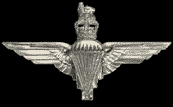 |
The
Arnhem
connection |
A plaque was unveiled in the Bourne Abbey Church on 29th April 2001 to commemorate the town's
link with the Parachute Regiment and the part it played during the Battle of Arnhem
more than half a century before. This was a little known chapter of the town's history that occurred during the Second World War when troops waiting to take part in this now famous action were billeted in the vicinity and established a bond that has never been broken.
Arnhem is a city in the Netherlands and the airborne operation was launched in an attempt to secure a bridgehead over the Rhine, thereby opening the way for a thrust towards the industrial areas of the Ruhr in Germany and a possible early end to the war. It took place between the 17th and 26th September 1944 but was only partially successful with 7,600 casualties and the action has since been immortalised in
Richard Attenborough's highly dramatised 1977 film A Bridge Too Far.
In the months preceding the action, troops were massed in eastern England
and particularly in Lincolnshire, where the airfields within easy reach of
the Continent were situated and so began the intricate logistical
operation of finding accommodation for them until the fateful day and Bourne was chosen to house the 1st Battalion of the Parachute Regiment.
The unit had returned to England from Italy in time for Christmas 1943 having been constantly in action with its two sister battalions for the previous 12 months, participating in the occupation of Algiers in North Africa, the seizure of Tunis and in helping Montgomery's Eighth Army drive out Rommel's retreating Africa Corps. The troops had established a reputation as an aggressive assault force, despite suffering enormous casualties but the unit still went on to the invasion of Italy
and once that had been securely established, the battalion sailed for home and awaited further orders.
An advance party came to Bourne at the beginning of November 1943 to start making the accommodation arrangements and the entire battalion of
almost 550 officers and men arrived by train at the end of the month. They established a headquarters at Grimsthorpe Castle and the various companies were encamped or billeted at Bulby Hall and in and around Bourne itself, at the
Bull (now the Burghley Arms), the Angel and the Nag's Head public houses.
The officers' mess was set up on the ground floor of the Masonic Hall, which was then situated behind Woolworth's store in North Street, while officers were given rooms at private homes.
Troops were also billeted at the former English Racing Automobiles workshops in the Spalding Road that
was taken over by the Delaine bus company in 1939. This building had been requisitioned by the army
for military accommodation at the outbreak of the war and a total of 240 paratroopers were stationed here. A cookhouse and latrines were added to the premises, both of which survived until building alterations in 1989-90.
Major Christopher Perrin-Brown, one of the battalion's company commanders, remembered later: "Although these troops were not particularly well behaved, there was a total absence of evil. The affinity between host and guest blossomed overnight and in retrospect, like a happy marriage, the loves and laughs remained. Joys and sorrows were shared and borne. Rationing was in force and meat was hard to come by but the hosts had their ways and their pigs and the guests responded with venison from the park, despite a near miss on a park keeper that was later explained as weapon testing. And then there were the bicycles! Suffice to say that if the lake at Grimsthorpe Park had been drained after the troops had departed, it would have yielded a veritable treasure trove of two-wheeled transport."
When the action became imminent, the 1st Battalion was briefed and then confined to quarters ready to depart but there were five false alarms before they eventually left on Sunday 17th September 1944. "It was a bright and lovely morning", recalled Major Perrin-Brown, "and the townspeople of Bourne thronged the streets as flight after flight of
transport aircraft flew low over the town from the nearby airfields at Colsterworth, Grantham and Barkston, supported by massed formations of Lancaster bombers. Then suddenly, the guests had gone. The town was empty."
Of the 10,000 troops dropped by parachute behind enemy lines over Arnhem, only 2,000 escaped back across the Rhine. Of the 545 members of the 1st Battalion who had been stationed in the Bourne area, 459 were killed, wounded, captured or reported missing. Major Perrin-Brown was captured and sent to a POW camp but he escaped at Christmas 1944 and after returning to England, joined the training brigade. He had already been awarded the MC for action in North Africa and the Arnhem campaign also earned him the DSO. After the war, he went to live at Folkingham
and died in 1995 aged 77. Other members of his unit returned after the war to marry local girls they had met while stationed in the town and settled here.
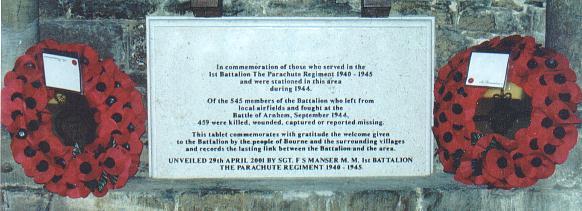 |
|
The Arnhem plaque in
Bourne Abbey, unveiled in April 2001 |
Local organisations held an exhibition at the Red Hall from 15th-16th September 1984 to commemorate the 40th anniversary of Arnhem and the town's part in the Second World War and it was officially opened by Major Perrin-Brown.
In the same month, nine members of the Bourne and District Round Table organisation drove a 1944 American jeep 400 miles to Arnhem to deliver an inscribed plaque from the mayor and citizens of Bourne to the burgomaster as a token of friendship between the two towns and he sent back a similar plaque to Bourne by return.
|
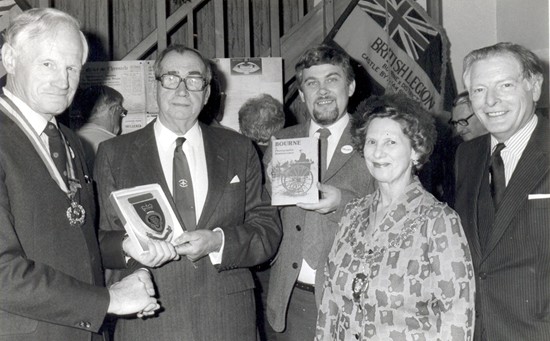 |
|
The Red Hall exhibition was organised by the
Civic Society and the Bourne branch of the Royal British Legion,
whose
chairman, Squadron Leader Eric Walton, MBE (RAF retired), is seen
here presenting a commemorative plaque to Major Perrin-Brown who
performed the opening ceremony (above) together with one of the many
displays of wartime memorabilia (right).
Pictures: (top) Squadron Leader J E
Walton MBE (RAF retired), chairman of the Royal British Legion
(Bourne), Major Perrin-Brown, John Megson, chairman of Bourne Civic
Society, Councillor Marjorie Clark, Mayor of Bourne, and Councillor
Don Fisher and (right) Councillor Fisher, Sir Christopher
Welby-Everard, president of the Royal British Legion (Lincolnshire),
Major Perrin-Brown, Squadron Leader Walton, Councillor Clark and
John Megson. |
 |
|
Streets on a new residential development
built in Mill Drove in 1994 remember several places involved in the
famous campaign including Arnhem Way, Oosterbeek Close, Lonsdale
Grove, Barkston Close and Pegasus Close. |
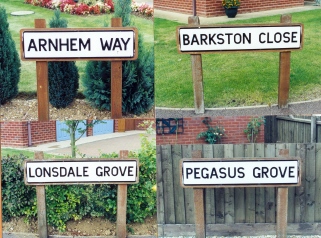 |
Ten years later, on Saturday 9th July 1994,
streets on a new residential development built in Mill Drove were named after
places involved in the famous campaign including Arnhem Way, Oosterbeek Close,
Lonsdale Grove, Barkston Close and Pegasus Close. An official naming ceremony
and parade was held attended by ex-sevicemen and members of the Spalding branch of
the Parachute Regimental Association when their chaplain, the Rev John
Moon, spoke of the significance of each name before the Last Post and
Reveille were sounded by bugler Steve Wand.
|
 |
|
The parade at the official naming ceremony led
by a piper and two pony mascots from the Parachute Regiment (above)
and civic leaders who took part in the parade headed by the
Parachute Regiment standards and the Mayor of Bourne, Councillor
Lesley Patrick, and Councillor Don Fisher (below). |
|
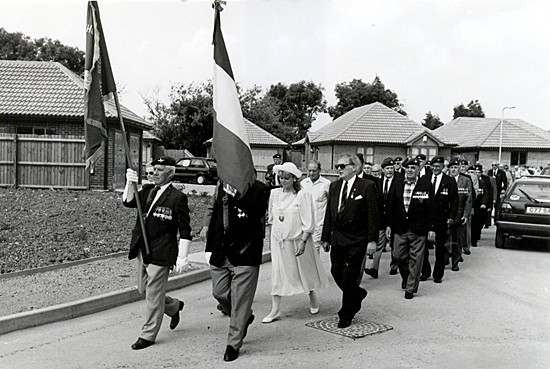 |
The
following day, there was a service at St James' Church,
Aslackby, to remember those who flew to Arnhem from the airfield at nearby
Folkingham and did not return. Veterans from France and the United States
attended and afterwards, there was a parade to the cemetery where a
memorial erected by the parish council to the Parachute Brigade and
American airborne divisions was dedicated. Then, exactly at 1 p m, the
time the battle had started, a Dakota aircraft that had been used during
the airborne operations at Arnhem, flew over in salute. It was a touching
moment for the Arnhem connection.
|
A TRIBUTE TO THE TROOPS
After the war, Mr Eric Trowell, Chief Financial
Officer to Bourne Urban District Council, decided to remember the troops
who had been billeted in the town before flying off to take part in the
Battle of Arnhem. He had made many friends among the men of the 1st
Battalion of the Parachute Regiment and continued to correspond with
several when the war ended in 1945. He therefore set himself the task of
compiling a book containing the citations of those who were decorated
during the battlalion's various campaigns from North Africa to Arnhem.
"The book is a monument to the compiler's skill and patience for Mr
Trowell has not only secured details of the citations from army
records but has also obtained the autographs of many of the men
mentioned", reported the Stamford Mercury on Friday 19th August
1949.
Also contained in the book was a complete list of the signatures of the
123 men who returned from Arnhem and were subsequently entertained at a
reception in the Corn Exchange at Bourne given by the townspeople.
Among those named in the book was an American journalist who was awarded
the Order of the Red Banner of Lenin and who later joined the British
paratroopers.
Unfortunately, it is not known what happened to this book or even if it
has survived. |
See
also Mill Drove
*The cap badge is reproduced above by courtesy of the Parachute
Regiment.

Go to:
Main Index Villages
Index
|






